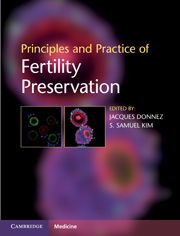Book contents
- Principles and Practice of Fertility Preservation
- Principles and Practice of Fertility Preservation
- Copyright page
- Dedication
- Contents
- Contributors
- Foreword
- Foreword
- Preface
- Acknowledgements
- Section 1 Introduction
- Section 2 Cancer biology, epidemiology and treatment
- Section 3 Reproductive biology and cryobiology
- Section 4 Fertility preservation strategies in the male
- Section 5 Fertility preservation strategies in the female: medical/surgical
- Section 6 Fertility preservation strategies in the female: ART
- Chapter 22 Embryo cryopreservation as a fertility preservation strategy
- Chapter 23 Oocyte cryopreservation
- Chapter 24 Cryopreservation of human oocytes and the evolution of vitrification technology for this purpose
- Chapter 25 Cryopreservation and transplantation of isolated follicles
- Chapter 26 ART and oocyte donation in cancer survivors
- Section 7 Ovarian cryopreservation and transplantation
- Section 8 In vitro follicle growth and maturation
- Section 9 Future technologies
- Section 10 Ethical, legal and religious issues with fertility preservation
- Index
Chapter 24 - Cryopreservation of human oocytes and the evolution of vitrification technology for this purpose
from Section 6 - Fertility preservation strategies in the female: ART
Published online by Cambridge University Press: 04 February 2011
- Principles and Practice of Fertility Preservation
- Principles and Practice of Fertility Preservation
- Copyright page
- Dedication
- Contents
- Contributors
- Foreword
- Foreword
- Preface
- Acknowledgements
- Section 1 Introduction
- Section 2 Cancer biology, epidemiology and treatment
- Section 3 Reproductive biology and cryobiology
- Section 4 Fertility preservation strategies in the male
- Section 5 Fertility preservation strategies in the female: medical/surgical
- Section 6 Fertility preservation strategies in the female: ART
- Chapter 22 Embryo cryopreservation as a fertility preservation strategy
- Chapter 23 Oocyte cryopreservation
- Chapter 24 Cryopreservation of human oocytes and the evolution of vitrification technology for this purpose
- Chapter 25 Cryopreservation and transplantation of isolated follicles
- Chapter 26 ART and oocyte donation in cancer survivors
- Section 7 Ovarian cryopreservation and transplantation
- Section 8 In vitro follicle growth and maturation
- Section 9 Future technologies
- Section 10 Ethical, legal and religious issues with fertility preservation
- Index
Summary
- Type
- Chapter
- Information
- Principles and Practice of Fertility Preservation , pp. 293 - 304Publisher: Cambridge University PressPrint publication year: 2011

